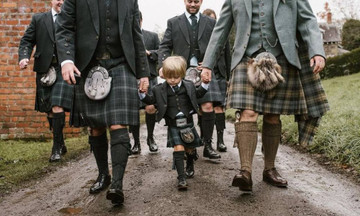Posted by Maris on 19th Feb 2024
How To Wear A Traditional Kilt: A Comprehensive Guide
One indication of Scotland's rich history and culture is the traditional kilt. Wearing a kilt is a mark of pride and heritage, not just style. The right way to wear a traditional kilt is essential whether you're attending a Scottish wedding, a Highland celebration, or you just want to honor your Celtic heritage. We will walk you through every step of the procedure in this comprehensive lesson, from choosing the ideal kilt to appropriately draping and accessorizing it. Now let's get started!
How to Wear a Traditional Kilt
Choosing the Perfect Kilt
You must first determine which traditional kilt is right for you before you can begin wearing one. Take into account the following elements:
Fabric: A variety of materials, including wool, tartan, and tweed, are available for kilts. Choose a material based on your personal preferences and the occasion. Each material has a distinct look and feel.
Tartan Pattern: Different clans and regions are represented by different tartan designs. To feel more connected to your past, if you have Scottish ancestors, learn the tartan of your clan.
Size: Selecting the right size is essential for a snug fit. Refer to the measurement chart provided by the kilt maker and take accurate measurements of your waist and hips.
Length: A traditional kilt should fall to your knee's center. Keep in mind that kilts that are too long or too short could seem strange.
Dressing Up Your Kilt
After you have your lovely kilt, it's time to appropriately accessorize it:
A bag that is worn around the waist and hangs in front of the kilt is called a sporran. It functions as a lovely decoration piece in addition to a practical one for carrying necessities.
Belt and Buckle: These elements help to maintain the kilt's snug fit. About an inch below the top of the waist, the belt is worn over the kilt.
Kilt Pin: The kilt pin stops the front apron from blowing in the wind and adds a little flare to your outfit. It is to be placed on the right side, about two inches from the side and two inches from the bottom of the kilt.

A Comprehensive Guide on Kilt Wearing

Put on Your Hose and Shirt: First, put on your hose and dress shirt. The shirt needs to be correctly tucked in, and the hose should stop just below your knee.
Arrange the Kilt: Place the kilt flat on the ground with the straps in front and the pleats in rear.
Put on the kilt and circumferentially wrap it around your waist, making sure the top of the waistband falls in line with your navel. The aprons of the kilt should slightly overlap.
Attach the Straps: Fasten the left side's straps first, followed by the right. Verify that the kilt fits snugly without becoming constrictive.
Attach the Belt and Buckle: Pull the belt over the kilt, ensuring that it covers the upper part of the waist. Tighten the buckle firmly.
Fold Down the Waistband: To create a polished and tidy appearance, fold down the waistband until it rests slightly above the belt.
Attach the Kilt Pin: Make sure the kilt pin is precisely in its place by carefully attaching it to the front apron.
To put on the sporran, wrap it around your waist and make sure the hem drapes just below the buckle.
Adding Extras to Your Kilt
Consider completing your traditional kilt outfit with these accessories:
Scottish traditional shoes known as "ghillie brogues" are made with long laces. They look great with the kilt and are appropriate for formal events.
Sgian Dubh: Tucked into your hose is a small, decorative knife known as the sgian dubh. It's a common element of traditional Highland attire.
Vest or Jacket: For a classy appearance, pair your kilt with a vest or a jacket depending on the situation.
Sash or Fly Plaid: If you want to look more formal, think about throwing a fly plaid or sash over your shoulder. This is usually reserved for important occasions.

